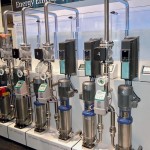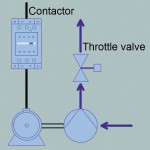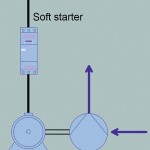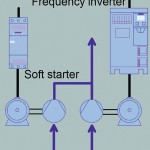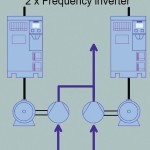The question as to which drive solution for pumps offers the highest energy efficiency is not an easy one. This is owed to the fact that both the requirements in terms of the application and the respective load profile essentially influence the selection from the manifold pool of solutions. An accurate analysis supports the right choice: four alternatives are described below.
The author: Andreas Thomas Project Manager Energy Efficiency, Siemens Industry Automation
The decisive factors when determining the most suitable drive solution for continuous-flow machines are the application’s delivery task, the delivery profile and the required control accuracy. Deciding on the optimal drive concept with regard to energy efficiency and cost effectiveness first requires an analysis of the application. Ultimately, the investment costs for drive technology and mechanical installation also have to be considered in addition to the operating costs.
These correlations can be aptly demonstrated on the basis of four drive solutions which serve different load profiles. An interesting pump model corresponding to these solutions will be exhibited at the Siemens trade show booth at Achema 2012 (Figure 1).
The objective was to maintain a defined filling level in a water basin within an open system – irrespective of the withdrawal volume, which varies according to the load profile. The four drive solutions shown in Figure 2 were therefore realised.
Four solutions
Classical throttle control (1 in Figure 2) represents a simple and economical solution in terms of purchase costs, installation and operation. In this example, it consists of a Sirius circuit breaker/contactor combination which drives the pump continuously. The delivery rate is controlled via an electromechanical throttle valve.
Two-point control (2) regulates the demand between previously defined minimum and maximum values by means of a simple pressure or level sensor. The Sirius soft starter used here ensures the constant availability of sufficient fluid without any major mechanical or hydraulic impact, regardless of the withdrawal volume.
However, continuous-flow machines are frequently subjected to greatly fluctuating delivery rates coupled with high control accuracy requirements. This is where the frequency inverter (3) comes in. A cascade circuit is also recommended in case of major load fluctuations in the higher performance range. In the model to be exhibited at Achema, the integrated staging function of the Sinamics G120P frequency inverter, which was especially optimised for pump applications, achieves automatic coverage of the highest possible base load by cascading fixed-speed drives that can be switched on or off according to demand by the inverter with its three integrated digital outputs via Sirius soft starters.
A solution with two frequency inverters is ideal for processes that require even greater control accuracy and speed (4). Even with massively fluctuating delivery rates, the inverters adjust the pump output to the required delivery rate rapidly and precisely. As a result, only the energy that is actually needed is absorbed and maximum control comfort ensured.
The cascade solution has other advantages and disadvantages for processes; these are linked on the one hand to the pumps’ redundancy and on the other to the more complex mechanical installation.
In any case, the preliminary sizing of the pump output should be very closely aligned to the system’s maximum demand. Oversizing as a result of multiple safety margins – something that is commonly observed in the framework of system inspections – often cancels out the savings realised on the drive side.
The process-specific decision criteria also include the system’s hydrostatic and hydrodynamic pressure conditions. With mainly hydrostatic system conditions (vertical delivery), a fixed-speed drive solution tends to be more advantageous, while with principally hydrodynamic conditions (horizontal delivery), the best energy results can often be achieved with variable-speed control.
Accurate advance analysis is a must
When the individual load profile curves were evaluated in the run-up to the trade show, it turned out that throttle control can definitely also offer competitive lifecycle costs in sce- narios with optimum sizing and pump capacity utilisation, i.e. with only very slight or infrequent throttling. By contrast, frequent strong throttling at fixed speeds is nonsense from an energy point of view.
Yet in practice, two-point control with a fixed-speed drive has proved to be a good solution here. This is due firstly to the ideal operation of the motor and pump at the nominal operating point and secondly to the fact that the motor is disconnected on reaching the maximum value. Frequent clocking should always be avoided, however. The solution’s ease of installation and maintenance are further points in its favour.
On the other hand, if the application requires accurate control, a frequency inverter is inevitable. Whereas a frequency inverter solution with only one pump can be employed with lower pump ratings or medium control ranges, larger pumps and wider control ranges call for a cascade solution. In this connection, the poor efficiency of the pump and motor in the lower performance range plays a vital (disadvanta-geous) role. Thanks to the higher efficiency of a cascaded pump solution compared to a large, stand-alone alternative, the additional expenditure usually pays off quickly due to the lower energy costs. A detailed analysis of the motor and pump characteristic curves – mirrored in the application’s load profile – reveals the optimum solution in terms of energy.
Then again, if high control dynamics are not essential, cascading a frequency inverter in combination with a soft or direct-on-line starter represents a better choice. This is explained by the low power loss inside the control cabinet. The lossy thyristors in the soft starter, for example, are bridged by means of contactor contacts after the soft starter has started up, resulting in a very low residual power demand in the main and control circuits. Moreover, this solution scores with low purchase costs as well as good controllability of the application via the frequency inverter.
No ideal solution
There is no one ideal drive concept from an economic and ecological point of view. The optimum solution can only be determined after an accurate analysis of the application and the load profile. This requires hydraulic and electrical engineers to work hand in hand in order to select the best alternative from the manifold pool of solutions.
Demand-based sizing of the required pump output and the avoidance of oversizing comprise the first steps towards this approach.
As far as the drive technology is concerned, both innovative fixed-speed and variable-speed solutions will still be necessary in the coming years. Yet purchase decisions will in future be swayed by the “ease of use” aspect, i.e. configuration and selection tools, automatic product documentation and CAx data generation, installation and operating simplicity, etc., as well as by system functionalities such as safety-related functions or seamless integration in the overall automation environment. In this context, suppliers like Siemens offer substantiated consulting services.
Hall 11.0, Booth C3
cpp-net.com/0212405
Share:



